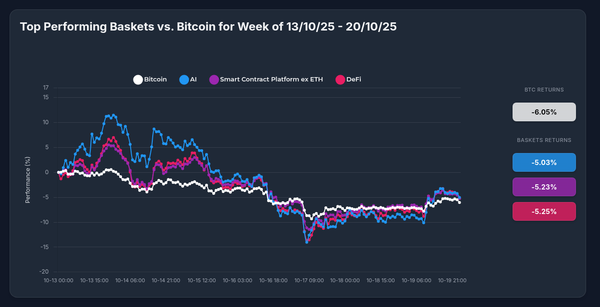Why Is Crypto Facing Headwinds Despite Record Government Spending?

Why Is Crypto Facing Headwinds Despite Record Government Spending?
November 5, 2025 Market Report
The crypto market is delivering a counterintuitive message: despite unprecedented fiscal deficits and selective credit expansion, Bitcoin has entered a technical bear market with a 20%+ pullback from October highs. For investors wondering whether to enter or exit crypto positions, understanding the liquidity dynamics at play is critical.
The Central Thesis: Liquidity Is Mixed, Not Missing
The bottom line: We're experiencing a temporary liquidity configuration mismatch—not a fundamental breakdown of the money supply thesis. The macro environment remains supportive for crypto over the medium term, but short-term headwinds are creating volatility.
What's Happening in the Macro Economy
🔴 United States: Record Deficits, Tariff Revenue, Rate Cuts
- Fiscal spending: $1.8 trillion deficit for FY2025 (7.6% of GDP)—massive government spending injecting liquidity into the private sector
- New revenue source: Record $32 billion in tariff collections (October)—though this represents money removed from circulation
- Credit markets: Bank lending cautiously recovering; commercial loans down 5.6% in H1 2025 but expected to improve as rates fall
- Federal Reserve: Recent 25 basis point rate cut to 7.00% prime rate—lower rates mean reduced government interest payments flowing to the private sector
🔵 European Union: Moderate Recovery
- Credit expansion: Household borrowing (mortgages) increasing steadily; corporate demand remains subdued due to trade uncertainties
- Policy stance: ECB transitioning from aggressive tightening (4.0% peak) to gradual easing
- Debt levels: Six G7 countries including EU members exceed 100% debt-to-GDP—high but stable
🟡 China: Credit Surge in Progress
- Bank loans: Dramatic jump from 590 billion CNY (August) to 1,290 billion CNY (September)—strong credit creation momentum
- Policy focus: Aggressive credit expansion to support growth amid global headwinds
- Projection: Loan volumes expected to remain robust (1,250-1,320 billion CNY) through 2027
What's Happening in Crypto Markets
📉 Short-Term Pressure
- Bitcoin: Down 20%+ from October highs, entering technical bear territory
- Liquidations: Over $19 billion in mid-October—severe deleveraging event
- Sentiment: Fear & Greed Index at 23/100 (Extreme Fear); market sentiment 24/100 (Bearish)
- ETF flows: Outflows indicating institutional hesitation
📈 Medium-Term Catalysts
- JPMorgan breakthrough: Institutional clients will use BTC/ETH as loan collateral by year-end—massive legitimization of crypto as financial assets
- Australian Bitcoin ETF: Expanding global access and regulatory acceptance
- Ethereum Fusaka upgrade: Enhanced transaction speed and efficiency—strengthening DeFi infrastructure
- BlackRock engagement: Continued institutional interest in Ethereum ecosystem
The Liquidity Paradox Explained
Here's why crypto is struggling despite supportive macro conditions:
- Tariffs are a tax: That $32 billion in tariff revenue removes money from circulation—counteracting some deficit spending benefits
- Rate cuts reduce liquidity: Lower interest rates = lower government debt service payments = less money flowing to bondholders in the private sector (contrary to popular belief)
- Credit recovery is slow: U.S. bank lending remains cautious despite rate cuts—businesses aren't borrowing aggressively yet because they're not seeing strong demand signals
- Regional divergence: While China is expanding credit rapidly, U.S. and EU credit creation is moderate, creating uneven global liquidity
- Sentiment override: In the short term, fear and deleveraging can override fundamental liquidity support
What This Means for Investors
Our assessment: The current crypto pullback is a volatility event within an intact bullish macro structure—not a regime change.
Supportive Factors (3-12 Months)
- $1.8 trillion U.S. deficit continues injecting liquidity
- China's aggressive credit expansion (1,290 billion CNY monthly) creates global liquidity
- Institutional adoption accelerating (JPMorgan collateral, ETFs, BlackRock)
- No QT impact on actual spending money (reserves ≠ bank deposits)
- Improving U.S.-China trade dynamics supporting risk assets
Near-Term Headwinds
- Tariffs extracting liquidity from private sector
- Rate cuts paradoxically reducing government interest payments to private sector
- Extreme fear sentiment (23/100) may persist until liquidation cycle completes
- U.S. credit markets still recovering, not accelerating
The Verdict: Strategic Opportunity in Tactical Weakness
For investors with a 6-12 month horizon, the current environment presents a strategic accumulation opportunity. The fundamental money supply thesis remains intact:
Government deficit spending ($1.8T) + Chinese credit expansion (1,290B CNY/month) + Institutional adoption (JPMorgan, ETFs) = Increased liquidity flowing toward crypto assets
The near-term volatility is noise created by tariff-induced liquidity extraction, rate cut dynamics, and sentiment extremes—not a breakdown of the underlying bullish structure.
Key Monitoring Points
- U.S. bank lending data: Watch for commercial loan growth acceleration
- Tariff policy: Further tariff increases would remove more liquidity
- China credit numbers: Sustained 1,200+ billion CNY monthly = strong global liquidity support
- Institutional adoption pace: JPMorgan's Q4 collateral rollout is a critical milestone
- Sentiment reversal: Fear & Greed above 40 would signal capitulation completion
Bottom line for investors: If you believe in crypto's role as a beneficiary of monetary expansion, current fear-driven prices offer better entry points than October's euphoria. The liquidity machine is running—just with different timing and composition than many expected.
This is not investment advice. Always conduct your own research and consult with financial professionals before making investment decisions.





